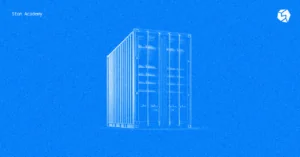
Blockchain — is this just about Bitcoin or something? Have you ever heard someone saying that? What about claims that blockchain is completely unhackable or that every transaction is anonymous? These are just a few of the misconceptions surrounding blockchain technology.
In this article, we’ll address some widespread myths about blockchain in general and the TON blockchain in particular, breaking them down in simple terms and clarifying common misunderstandings.
Myth 1: Blockchain Is Only About Cryptocurrencies
This is one of the most common misconceptions. In reality, blockchain is a distributed ledger technology that can be applied across various industries, not just for cryptocurrencies. Real-world examples of blockchain applications:
- Maersk. Uses blockchain to manage global shipping logistics, streamlining the tracking of cargo across the seas.
- Walmart. Implements blockchain for fresh produce supply chain management, ensuring instant verification of the product’s history.
- Estonia. Integrates blockchain in its e-government system to secure digital records.
- Georgia. Uses blockchain to register real estate transactions.
- Dubai. Plans to move 50% of all government documents to blockchain by 2030.
Myth 2: Blockchain Is Absolutely Secure and Unhackable
While blockchain is highly secure, it isn’t 100% immune to attacks. Its security comes from several key mechanisms:
- Cryptographic hashing. Think of hashing like a digital fingerprint for data. If even one tiny detail changes, the “fingerprint” changes dramatically.
- Distributed data storage. Instead of data being stored in one place, it’s spread across many nodes, making it hard to alter all copies simultaneously.
- Consensus mechanisms. The network must agree before any change is made, adding another layer of security.
However, blockchain has vulnerabilities. For instance:
- 51% Attack. If an attacker gains control of more than 50% of the network’s computational power, they can alter transaction history. In 2018, Bitcoin Gold suffered a 51% attack, resulting in $18 million being stolen.
- Smart contract vulnerabilities. Bugs in smart contracts can be exploited by hackers. In 2016, Ethereum’s DAO was hacked, leading to a major rollback of transactions.
- Double-spend attacks. The same digital asset is spent more than once, undermining trust in the network.
- Quantum computing threats. Future quantum computers might crack current cryptographic methods.
Myth 3: All Blockchain Transactions Are Anonymous
Blockchain transactions are not fully anonymous; they are pseudonymous. This means transactions are tied to cryptographic addresses, not personal identities. However, with enough effort, these addresses can be linked back to real people.
Imagine your blockchain address like a nickname. If someone can connect that nickname to you through other clues, your transactions become traceable.
How is this done?
- Blockchain explorers allow anyone to view transactions and addresses.
- If an address is used to send or receive funds on an exchange where KYC (Know Your Customer) is required, it can be linked to your identity.
- Investigators often track patterns and link multiple addresses to identify users.
Myth 4: Blockchain Solves All Decentralization Issues
Blockchain addresses many problems related to trust and transparency, but it isn’t a magic solution for every issue. Here’s what blockchain can and cannot solve.
Problems blockchain can solve:
- Eliminating intermediaries. Direct peer-to-peer transactions reduce the need for middlemen.
- Providing transparency and data integrity. All transactions are publicly verifiable. Once recorded, data cannot be tampered with easily.
Problems blockchain cannot solve:
- Human error in code. Bugs or flaws in smart contracts or applications.
- Mining power centralization. When a few players control the majority of mining power.
- Dependence on core teams. Early-stage projects may still rely on founding teams.
Myth 5: Blockchain Transactions Are Instantaneous
Blockchain transactions take varying amounts of time depending on the network.
| Bitcoin | Etherium | TON | |
| Transactions per second (TPS) | 7 | 15-30 | 100,000 |
| Confirmation Time | 10-60 minutes | 15-30 seconds | 2-5 seconds |
The speed depends on factors like network load, block size, and consensus mechanisms. TON’s multi-threaded architecture allows it to achieve much higher transaction speeds compared to traditional blockchains like Bitcoin and Ethereum.
Myth 6: Cryptocurrencies Are Financial Pyramids
While there have been scams in the crypto world, blockchain technology itself is not a pyramid scheme. Let’s clarify the difference.
Characteristics of a Financial Pyramid:
- No real product or service.
- Profits rely on recruiting new participants.
- Returns with no transparency.
Principles of Blockchain:
- Open-source. Anyone can audit the code.
- Real value. Tokens derive value from demand and utility.
- Decentralization. No central authority.
- Transparent transactions. All transactions are publicly recorded.
Myth 7: Blockchain Is Free
Blockchain transactions require fees (often called gas fees). These fees compensate miners or validators for securing the network and processing transactions.
- Bitcoin. Fees can vary from a few cents to $20+ during high congestion.
- Ethereum. Gas fees can range from $1 to $50+, depending on network load.
- TON, Known for low fees, transactions typically cost a fraction of a cent.
In addition to gas fees, other fees may apply, such as:
- Storage fees. For storing data on the blockchain.
- Network fees. For interacting with certain decentralized applications.
Myth 8: Blockchain Is Only for Tech Experts
Today, blockchain is more accessible than ever. User-friendly tools simplify blockchain interactions for non-technical users. Have a look at these examples:
- Mobile wallets (e.g., MetaMask, Tonkeeper). Easy-to-use apps for managing crypto.
- Exchanges (e.g., STON.fi). Intuitive interfaces for trading.
- NFT platforms (e.g., OpenSea). Simplifies buying and selling digital art.
TON-Specific Myths
Myth 1: TON Is a Telegram Project
While TON originated with Telegram, it is now an independent, open-source project maintained by a global community of developers.
Myth 2: TON Is Only for Crypto Transactions
TON supports a wide range of applications, such as:
- TON Domains. Decentralized domain names.
- TON Storage. Distributed file storage.
- TON Payments. Microtransactions for Telegram bots.
Myth 3: TON Has Low Security
TON uses advanced cryptographic protocols and a Proof-of-Stake (PoS) consensus mechanism, which ensures high security and resilience.
💡 TON has not experienced any successful mass attacks.
Proof-of-Stake (PoS) is a method used by blockchains to verify transactions. Instead of using energy-intensive mining, validators are chosen based on how many tokens they “stake” (lock up) as collateral. The more they stake, the higher the chance of being selected to validate new transactions and earn rewards. Validators are motivated to behave honestly because they risk losing their staked tokens if they attempt to cheat.
This approach is energy-efficient and reduces the risk of centralization since it doesn’t require massive computing power.
Myth 4: TON Is a Copy of Other Blockchains
TON’s architecture is unique due to its multi-threaded structure and dynamic sharding.
A multi-threaded structure in a blockchain allows different transactions or tasks to be processed simultaneously by breaking them into separate “threads” or pathways. This is similar to how a computer can run multiple programs at once without slowing down significantly.
Dynamic sharding refers to the ability of the blockchain to automatically split into smaller parts, called shards, to distribute the workload. Each shard can process transactions independently. If one shard gets overloaded, the system dynamically creates new shards to balance the load. This is like dividing a long line at a store among several checkout counters to serve customers faster.
Together, these features enable TON to handle a high volume of transactions while maintaining speed and scalability.
Myth 5: TON Is Slow
TON’s network can process up to 100,000 transactions per second, making it one of the fastest blockchains available.
Blockchain technology, including TON, holds immense potential beyond cryptocurrencies. By debunking these myths, we hope to bring more clarity and understanding to this technology.





